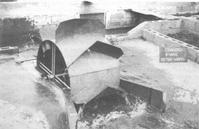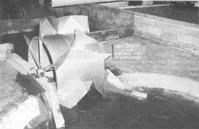


Chapter 3
I Background
II Early European Settlements
III Assessment Of Available Water Resources
IV Water Supplies For Goldmining Development
V Irrigation Development
i Channels, weirs and barrages
ii Measuring farm supplies - the Dethridge wheel
iii Early pumping schemes
iv Irrigation techniques
v Drainage of irrigated land
vi Recharge of aquifer
vii Soil-plant-water relationships
viii Carry-over storages and security of supply
VI Farm And Stock Water Supplies
VII Urban Water Supplies
VIII Wastewater Management And Treatment
IX Water Quality Management
X Limnological And Water Quality Research
XI New Techniques In Water Resource Planning And Management
XII Legislation
XIII Conclusion
XIV List Of Abbreviations
XV Acknowledgements
XVI Plantations-high Productivity Resources
References
Index
Search
Help
Contact us

Measuring farm supplies - the Dethridge wheel
As the area under irrigation increased, landowners developed a better understanding of the Australian climate and the water needs of different forms of agriculture. The concurrent increase in the assessment of the country's water resources indicated that there were significant limits to the exploitation of these resources. All these factors pointed to the need for measuring the volumes of water delivered to individual farms. This need was satisfied by the development in 1910 of the Dethridge Meter, (Fig. 6) a simple flow measuring device characterised by integration of total discharge, accuracy over a wide range of discharge, low head loss, robust and simple construction, ease of maintenance and relatively low cost. The Dethridge Meter has been progressively improved over a number of years with the use of new materials and construction techniques and the introduction of features aimed at eliminating interference by landowners, but the essential elements of the original hydraulic design were virtually unchanged. The meter delivers up to 12 ML/d within an overall accuracy of ±3 per cent.

In recent times higher flow rates and lower head losses have been required for supply to improved farm layouts using land forming controlled by laser levelling. The hydraulic concept of the meter was reassessed and significantly improved through design complemented by hydraulic testing, to give increased flow rates up to 21 ML/d, still with high accuracy. The wheel vane shape and number of vanes and emplacement floor shape had been modified for the revised Dethridge-Long Meter. The Dethridge wheel is used throughout Australia and in many other countries including U.S.A., Israel and Africa.
 |
Australian Academy of Technological Sciences and Engineering |  |
© 1988 Print Edition page 161, Online Edition 2000
Published by Australian Science and Technology Heritage Centre, using the Web Academic Resource Publisher
http://www.austehc.unimelb.edu.au/tia/157.html